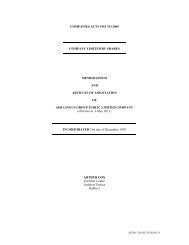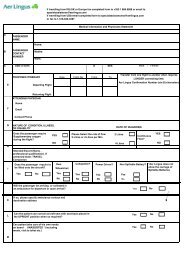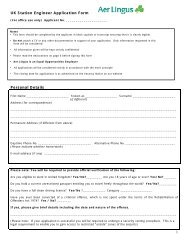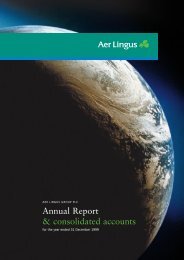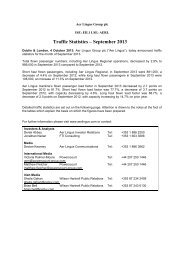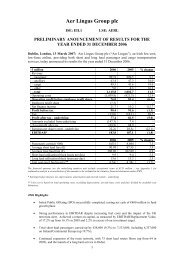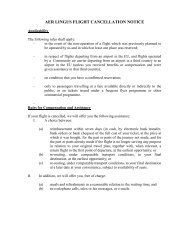annual report 2009 - Aer Lingus
annual report 2009 - Aer Lingus
annual report 2009 - Aer Lingus
You also want an ePaper? Increase the reach of your titles
YUMPU automatically turns print PDFs into web optimized ePapers that Google loves.
58 Financial Statements <strong>Aer</strong> <strong>Lingus</strong> Group Plc – Annual Report <strong>2009</strong>Notes to the Consolidated Financial Statements [continued]2 Summary of significant accounting policies [continued]2.9 Offsetting financial instrumentsFinancial assets and liabilities are offset and the net amount <strong>report</strong>ed in the statement of financial position when there is a legallyenforceable right to offset the recognised amounts and there is an intention to settle on a net basis, or realise the asset and settle theliability simultaneously.2.10 Impairment of financial assets(a) Assets carried at amortised costThe Group assesses at the end of each <strong>report</strong>ing period whether there is objective evidence that a financial asset or group of financial assetsis impaired. A financial asset or a group of financial assets is impaired and impairment losses are incurred only if there is objective evidenceof impairment as a result of one or more events that occurred after the initial recognition of the asset (a ‘loss event’) and that loss event(or events) has an impact on the estimated future cash flows of the financial asset or group of financial assets that can be reliably estimated.The criteria that the Group uses to determine that there is objective evidence of an impairment loss include:• significant financial difficulty of the issuer or obligor;• a breach of contract, such as default or delinquency in interest or principal payments;• the Group, for economic or legal reasons relating to the borrower’s financial difficulty, granting to the borrower a concessionthat the lender would not otherwise consider;• it becomes probable that the borrower will enter bankruptcy or other financial reorganisation;• the disappearance of an active market for that financial asset because of financial difficulties; or• observable data indicating that there is a measureable decrease in the estimated future cash flows from a portfolio of financialassets since the initial recognition of those assets, although the decrease cannot yet be identified with the individual financialassets in the portfolio, including:(i) adverse changes in the payment status of borrowers in the portfolio; and(ii) national or local economic conditions that correlate with defaults on the assets in the portfolio.The Group first assesses whether objective evidence of impairment exists.The amount of the loss is measured as the difference between the asset’s carrying amount and the present value of estimated futurecash flows (excluding future credit losses that have not been incurred) discounted at the financial asset’s original effective interest rate.The asset’s carrying amount is reduced and the amount of the loss is recognised in the consolidated income statement. If a loan orheld-to-maturity investment has a variable interest rate, the discount rate for measuring any impairment loss is the current effectiveinterest rate determined under the contract. As a practical expedient, the Group may measure impairment on the basis of aninstrument’s fair value using an observable market price.If, in a subsequent period, the amount of the impairment loss decreases and the decrease can be related objectively to an eventoccurring after the impairment was recognised (such as an improvement in the debtor’s credit rating), the reversal of the previouslyrecognised impairment loss is recognised in the consolidated income statement.(b) Assets classified as available-for-saleThe Group assesses at the end of each <strong>report</strong>ing period whether there is objective evidence that a financial asset or a group of financialassets is impaired. For debt securities, the group uses the criteria referred to in (a) above. In the case of equity investments classifiedas available-for-sale, a significant or prolonged decline in the fair value of the security below its cost is also evidence that the assets areimpaired. If any such evidence exists for available-for-sale financial assets, the cumulative loss – measured as the difference betweenthe acquisition cost and the current fair value, less any impairment loss on that financial asset previously recognised in profit or loss –is removed from equity and recognised in the separate consolidated income statement. Impairment losses recognised in the separateconsolidated income statement on equity instruments are not reversed through the separate consolidated income statement. If, in asubsequent period, the fair value of a debt instrument classified as available-for-sale increases and the increase can be objectively relatedto an event occurring after the impairment loss was recognised in profit or loss, the impairment loss is reversed through the separateconsolidated income statement.Impairment testing of trade receivables is described in Note 2.13.



